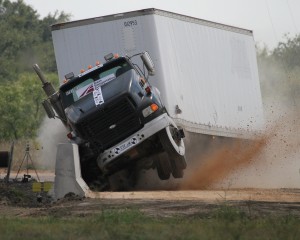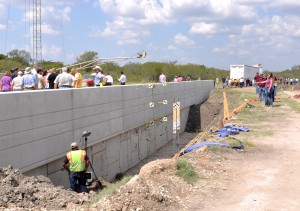On Sept. 26, for the first time in Texas A&M Transportation Institute (TTI) history, a crash test at TTI’s Proving Grounds was broadcast live via the Internet to clients and stakeholders across the country.

Providing live streaming crash tests was the brainchild of Dean Alberson, assistant agency director and manager of the TTI Crashworthy Structures Program, who began looking into the possibility more than a year ago.
“Having clients able to view their crash test live at our facility from back in their home office as it happens seemed like a logical next step for us,” Alberson says. “First of all, it would save them the expense of traveling. And there have been times when a crash test had to be postponed because of weather or other conditions. In those cases, the client wasted a trip here.”
The National Cooperative Highway Research Program (NCHRP) crash test involved an 18-wheeler traveling at 50 miles-per-hour and crashing at a 15-degree angle into a concrete barrier that was placed on top of a retaining wall.
“There were 176 computers that viewed the crash test,” Brad Hoover, TTI chief information officer, says. “We’re not sure how many people viewed, but it is clear that this initial live crash test was a popular event among NCHRP panel members.”
Based on the success of this first live-streaming crash test, TTI might offer it to other clients in the future. As for the crash test itself, it had two objectives according to TTI Roadside Safety Program Manager Roger Bligh, who was the principal investigator on the project.

“We wanted to determine how much force was transmitted in the underlying retaining wall so we can develop proper design guidelines for both the wall and the barrier system,” he says. “All indications are that the test went well, and the design of the wall and the barrier did their job.”
Co-principal investigator Jean-Louis Briaud, manager of TTI’s Geotechnical and Geoenviornmental Program, says numerous four-dimensional numerical simulations were performed on the retaining wall before the crash test was performed.
“Because of space limitations, more and more of these retaining walls — called mechanically stabilized earth walls — are being used for road construction in urban areas. It’s important that we know that they will hold up during a crash,” Briaud says.